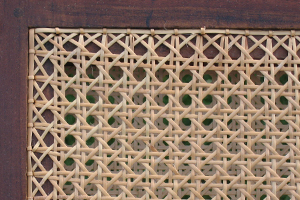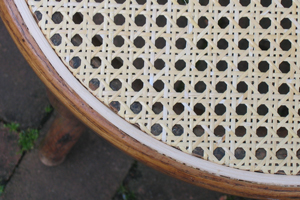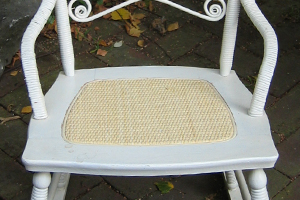Cane
Cane is the outer bark of the rattan palm. When moist, it is flexible and can be woven into a variety of patterns. As it dries, it becomes tight, for a durable, comfortable mesh. Below are examples of the two most common ways of attaching cane to a chair frame and a few patterns that it can be woven in.
 Hand cane is woven strand by strand on the chair. The cane passes through small holes
drilled in the panel frame in an eight step process. This method is time intensive, but
it gives a strong, unique seat that can last for years. A hand-caned chair can be
identified by the holes in the frame, usually covered with a strand of wider material
called binder cane.
Hand cane is woven strand by strand on the chair. The cane passes through small holes
drilled in the panel frame in an eight step process. This method is time intensive, but
it gives a strong, unique seat that can last for years. A hand-caned chair can be
identified by the holes in the frame, usually covered with a strand of wider material
called binder cane.
 Press cane, sometimes called machine cane, is hand-woven into long rolls. Sections cut
cut to size are attached to a chair by means of spline glued into a narrow groove along
the edge of the panel. The presence of the spline, as shown in the photo, is the easiest
way to distinguish machine cane from hand cane. Many patterns other than the traditional
octagons are available. A few are illustrated below.
Press cane, sometimes called machine cane, is hand-woven into long rolls. Sections cut
cut to size are attached to a chair by means of spline glued into a narrow groove along
the edge of the panel. The presence of the spline, as shown in the photo, is the easiest
way to distinguish machine cane from hand cane. Many patterns other than the traditional
octagons are available. A few are illustrated below.
 Modern cane is just like machine cane in its production and application. However, the
traditional octagon pattern is replaced with a modern pattern, such as an open or closed
checkerboard pattern.
Modern cane is just like machine cane in its production and application. However, the
traditional octagon pattern is replaced with a modern pattern, such as an open or closed
checkerboard pattern.
